'Floating' Buseoksa Temple
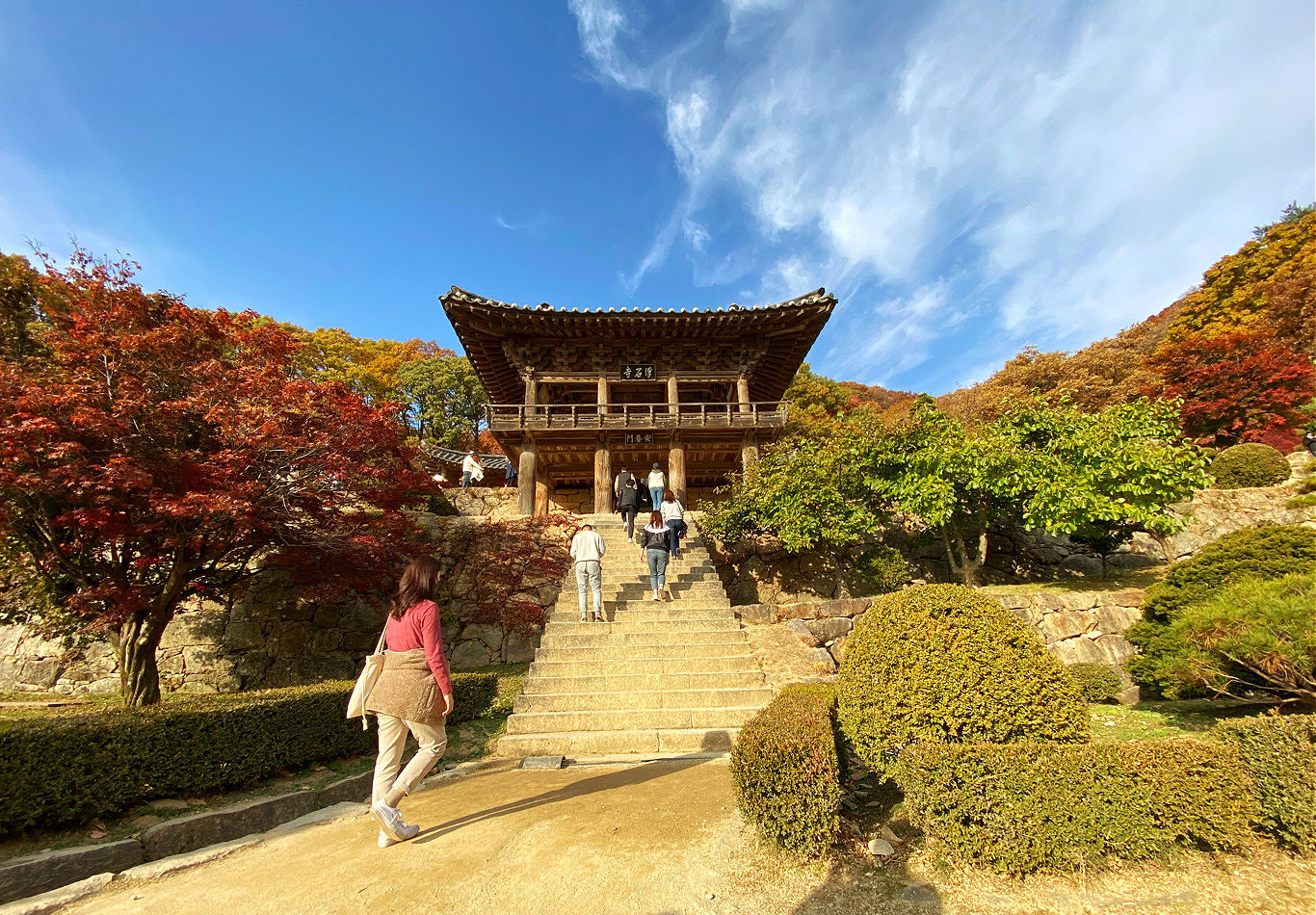 A fantastic sight of Buseoksa Temple area
A fantastic sight of Buseoksa Temple areaINtroduction
Buseoksa Temple is a famous and beautiful temple area in South Korea. It is located in the city of Yeongju, which is about 250 km southeast of Seoul. The temple was founded by the famous monk Uisang in 676 and has been a major cultural attraction ever since.
The main temple building at Buseoksa Temple is said to be one of the oldest wooden structures in Korea, having survived for over 1,300 years. The temple grounds are also home to several other buildings, including the main hall, a lecture hall and several smaller shrines and pavilions.
The area around Buseoksa Temple is known for its stunning natural landscape as well. There are many nearby mountains, rivers and caves that can be explored, and the temple is also surrounded by a large wall. Visitors can take in the beautiful scenery while walking around the grounds of the temple and learning about its history.
Another popular activity at Buseoksa Temple is to enjoy a traditional Korean tea ceremony with local tea masters. This ancient ritual is said to bring peace of mind and harmony to those who participate. Visitors can also pay their respects by offering coins at the temple's statues and reading sutras in front of its main hall.
Buseoksa Temple is a wonderful place to visit if you want to experience traditional Korean culture and history. The area around the temple is beautiful, and it's a great way to learn more about Korean culture. Whether you're looking for a peaceful retreat or an exciting adventure, Buseoksa Temple is sure to provide you with an unforgettable experience.
Don't forget to take lots of pictures and create lasting memories! Visit Buseoksa Temple today and get ready to explore the history and culture of one of Korea's most sacred sites.
Soak in the atmosphere, marvel at the architecture and make sure to remember the importance of harmony, balance and peace that this temple has long stood for. Enjoy!
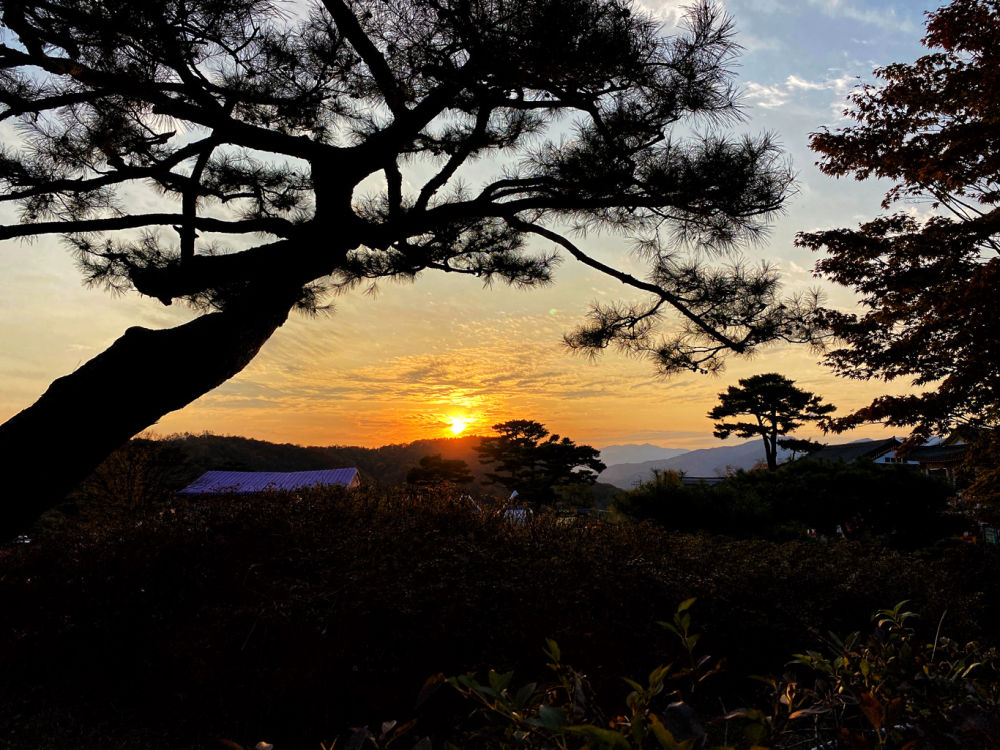 Sunset view at Buseoksa Temple area. It's so peaceful and calming. Life is too short of taking these moments for granted — make sure you take time out of your day to appreciate the little things. Whether it's a beautiful sunset, birds chirping in a nearby tree or the sound of wind rustling through the leaves — take time to enjoy it! You'll be thankful you did.
After taking some time for yourself, why not explore the Buseoksa Temple area?
Sunset view at Buseoksa Temple area. It's so peaceful and calming. Life is too short of taking these moments for granted — make sure you take time out of your day to appreciate the little things. Whether it's a beautiful sunset, birds chirping in a nearby tree or the sound of wind rustling through the leaves — take time to enjoy it! You'll be thankful you did.
After taking some time for yourself, why not explore the Buseoksa Temple area?Floating Stone Buseoksa Temple
For the first time, I visited Buseoksa Temple in a very timely autumn season when the leaves turn into a myriad of beautiful colors--red, orange, pinkish, yellow, and other soothing colors in that range.
Literally, the name Buseoksa means "floating rock temple." It is a name given to this temple area because of the legendary, seemingly floating stone located beside the main temple hall.
It was very timely and peak season that I was astonished to see cars packing the parking lot and excited visitors crisscrossing and heading towards the temple area.
My excitement started to build up not only because I always love experiencing the serene atmosphere of temple areas but also because we were driving amidst the colorful autumn leaves, some of them falling while we were heading towards our destination.
KNOW THESE:
What: Buseoksa is a Buddhist temple built in 676.
Where: Buseoksa is located in Yeongju City, Gyeongsangbuk Province, South Korea
How: Take a public transportation train, bus, taxi) to Yeongju City (see more below)
Status: UNESCO Site
Features: old temples, floating stones, autumn leaves, ancient pagodas, spring flowers, strolling paths, pine trees, fountains, etc.
![Buseoksa Temple [부석사, 경상북도] buseoksa-temple](https://www.koreattrack.com/images/xbuseoksa-temple-old-temple-view.jpg.pagespeed.ic.ZkckhKTiOR.jpg) Technicolor leaves at Buseoksa Temple [부석사, 경상북도]
Technicolor leaves at Buseoksa Temple [부석사, 경상북도]
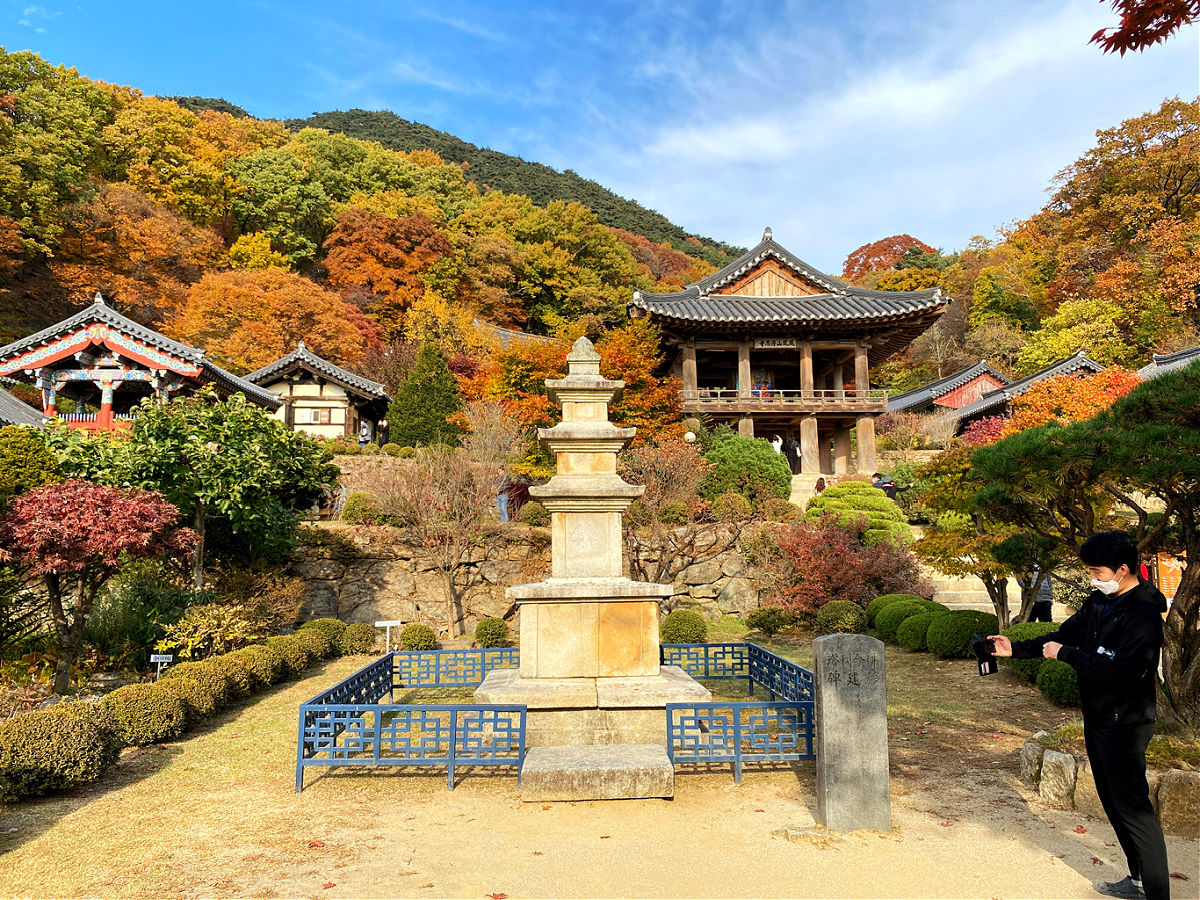 A pagoda on the left side A pagoda on the left side |
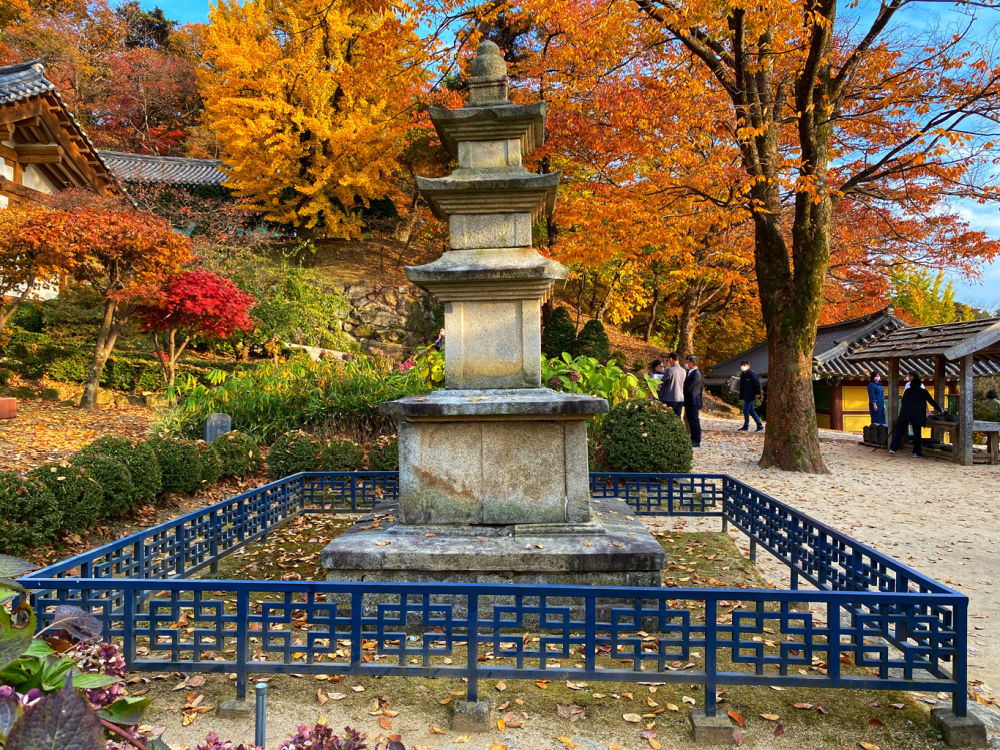 Pagoda on the right-hand side [부석사 파고다] Pagoda on the right-hand side [부석사 파고다] |
Unique Features of Buseoksa Temple Area
The public areas of Buseoksa Temple is for everybody else--children, teenagers, youth, adults, and even for elderly. It means that you have various places or aspects of the area that can make your day's visit. Such are the following...
- Public Entrance area: waterfalls, entertainment, restaurants
- Structures: temples, pagodas, old structures, ancient rocks
- Views of the distant mountains and valleys
Now, most of the exciting items found within the temple area I already mentioned above. So, let me now describe them in some details as much as I can remember. And hopefully, the pictures and photos will describe my experiences better than my limited words and expressions!
And I will only feature and describe things which I found really
impressive and exciting, hoping this article would give you more
information, if not, insights about the area.
So, let me begin with...
Fountain Area
After passing through the packed parking area (Saturday during the Autumn season), I was immediately greeted by the fountain area's exciting sight.
I couldn't believe that although this is supposed to be a temple area, one can find this human-made fountain. So, without any hesitation, I took out my phone and started taking photos.
Since I enhanced my photography skills through online lessons, I felt more confident to shoot sights, especially this fountain subject and its surrounding scene. (Still learning, but I hope I'm getting better though! ^^).
You can stay around the fountain area to enjoy its dancing water and controlled showers while watching the waterfalls that works at intervals. Yes, they are timed, and so it means you won't see them flowing all the time.
It was a fantastic introduction to me as I did not expect to watch that spectacle!
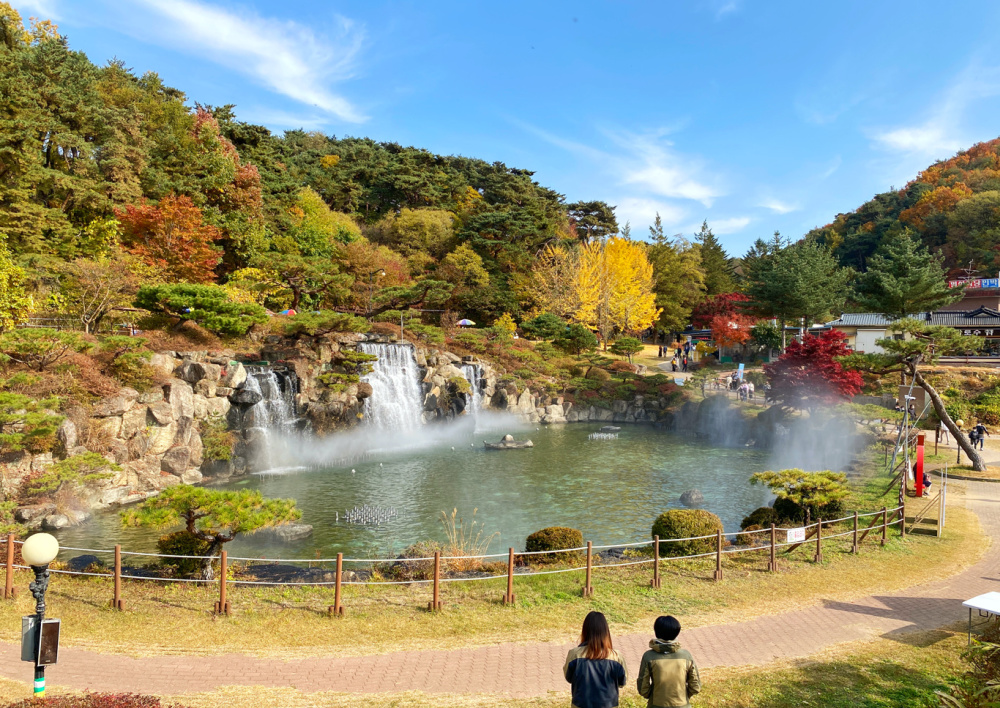 Beautiful human-made waterfalls and fountains area
Beautiful human-made waterfalls and fountains areaWalking Amidst Technicolor Leaves
After taking many shoots and a couple of short videos, without delay, as I don't want to miss anything about this area, I immediately walk towards the direction where people are moving.
I was not really certain that I was going in the right direction as there were no apparent signs to the temple except that everybody was moving towards something exciting. I trust my feeling that I was moving towards where everybody would want to be going (^^).
The excitement really got started where I reached the Ticketing Booth area. People lined up waiting for their turn under the technicolor autumn leaves of Maple trees and other tree species.
Then I saw an apple orchard on my left-hand side with apples still clinging and waiting to be harvested. What an incredible sight!
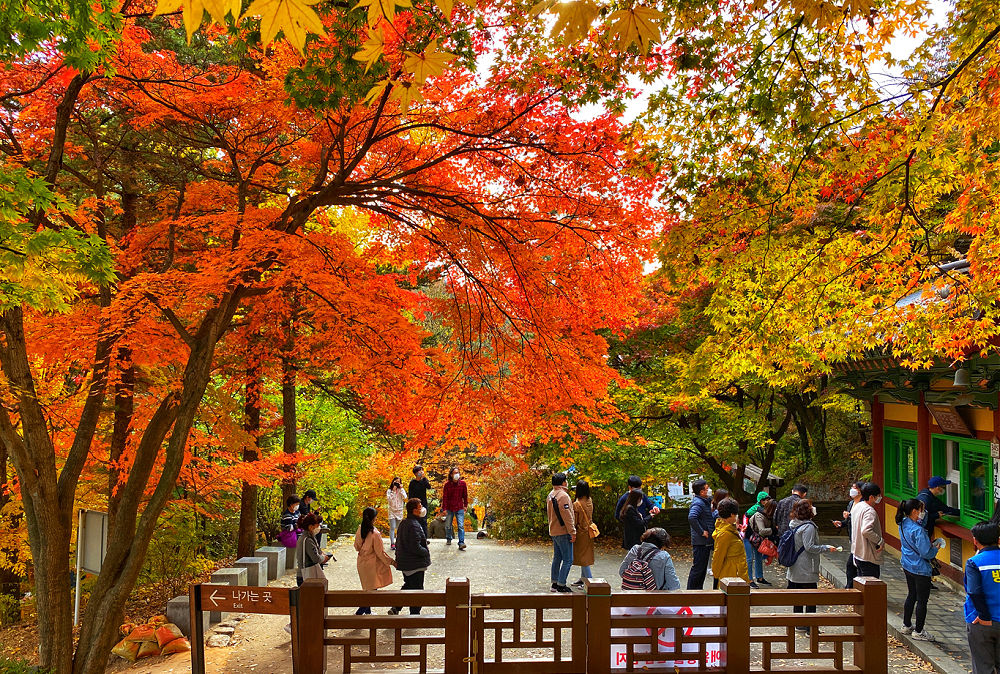 Fiery and technicolor leaves at the ticketing booth area
Fiery and technicolor leaves at the ticketing booth areaPassing Through the Gates
One of the things I enjoy when visiting temple areas is the wooden gates. They all look mysterious, beautiful, and welcoming to me.
You will notice that they are specially painted with various colors, adorned with Buddhist symbols such as guardian sculptures. As they have roofs, they certainly serve as protection from sunlight, rain, or snow for the passersby.
And one of the things you will notice for each gate are the names of the gates. They are made to describe its meaning and point to something meaningful about the temple area.
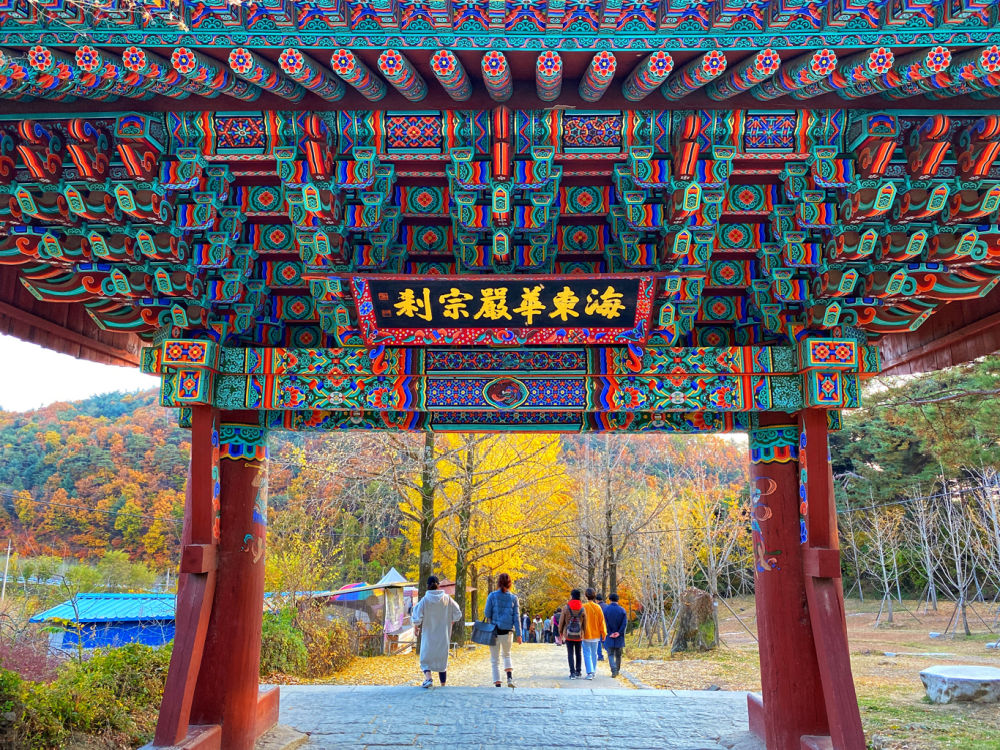 One of the gates that lead to the main temple area
One of the gates that lead to the main temple areaStairs & Entrance Gates
Following the crowd, I found myself climbing the stone steps and passing through gates.
I believe that the number of stone steps that lead to Muryangsujeon, the Main Hall, is 180, which is a symbolic number for Buddhism faith. I felt confident and felt no difficulty climbing those steps than some little children who are literally struggling by crawling upwards!
The more I move upwards to the temple area, the better the sights before me and the views behind me of the valley. Reaching the main hall area gives you the most beautiful views of the temple area, plus the mountain's surrounding views in the distant part of the province.
Stone Flagpole Supports
You can find these flagpoles erected somewhere midway before you arrive at the main Hall of the Buseoksa Temple area.
You won't miss seeing these flagpole supports as they are huge enough to be ignored (on your left-hand side as you ascend to the temple area). These stone columns were used to hold a flagpole on which flags were hoisted announcing any special religious event.
Each stone is over four (4.28) meters tall. Each right and left sides of the supports has no embellishments, while their front and rear sides have three vertical carved lines.
According to the descriptions, the top of the 'flagpole supports' each has a rectangular groove through which a flagpole is inserted.
You can find carvings of lotus flowers at the low square stone placed between the supports and other features used to fix the flagpole securely.
With the stability and function of this flagpole supports, you will also see that its carving techniques and style are simple but elegant. It is believed to be produced during the 9th century of the Unified Silla Period.
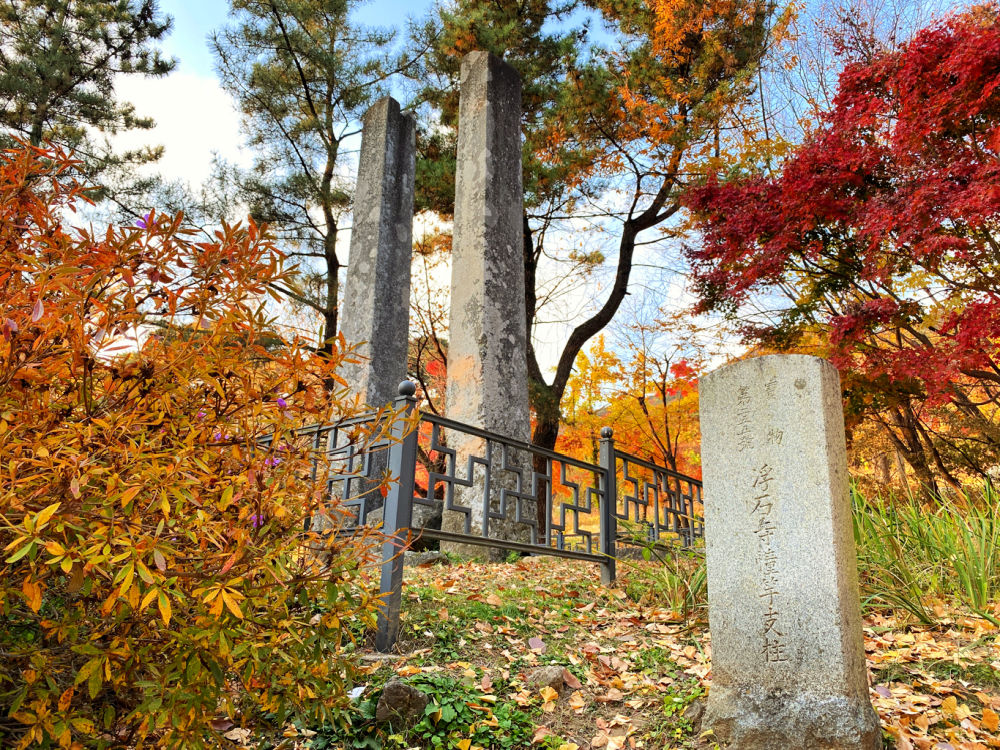 A pair of ancient stone flagpole supports along the road to the temple
A pair of ancient stone flagpole supports along the road to the templeMuryangsujeon (Main Hall)
Muryangsujeon is the Main Hall of Buseoksa Temple, where believers mostly come to pray or meditate. Even if you are a non-believer (yet!), you won't be stopped to come in as long as you keep the ethical practices you need to observe.
Muryangsujeon is where they enshrine the statue of Amitabha Buddha, the principal Buddha of Pure Land, according to the Buddhist belief.
Although experts could not find any records of the statue, they believe that the Hall itself was constructed as the central part of the temple area.
Muryangsujeon was established by Master Uisang (625-702) in 676. The main Hall was renovated by another monk (Wonyung) in 1016 (the 7th year of King Hyeongjong of Goryeo's reign).
However, the Hall got burned down later on during a foreign invasion in 1358, the 7th year of King Gongmin's rule of the Goryeo Dynasty.
Then Muryangsujeon was rebuilt in 1376 by Venerable Woneung during the second year of Kung U's reign of the Goryeo Dynasty.
The Hall's repair continues in 1611 during the third year of King Gwanghae's reign of the Joseon Dynasty.
In 1916, Muryangsujeon was repaired by disassembling first, then putting them back together, which we can see today.
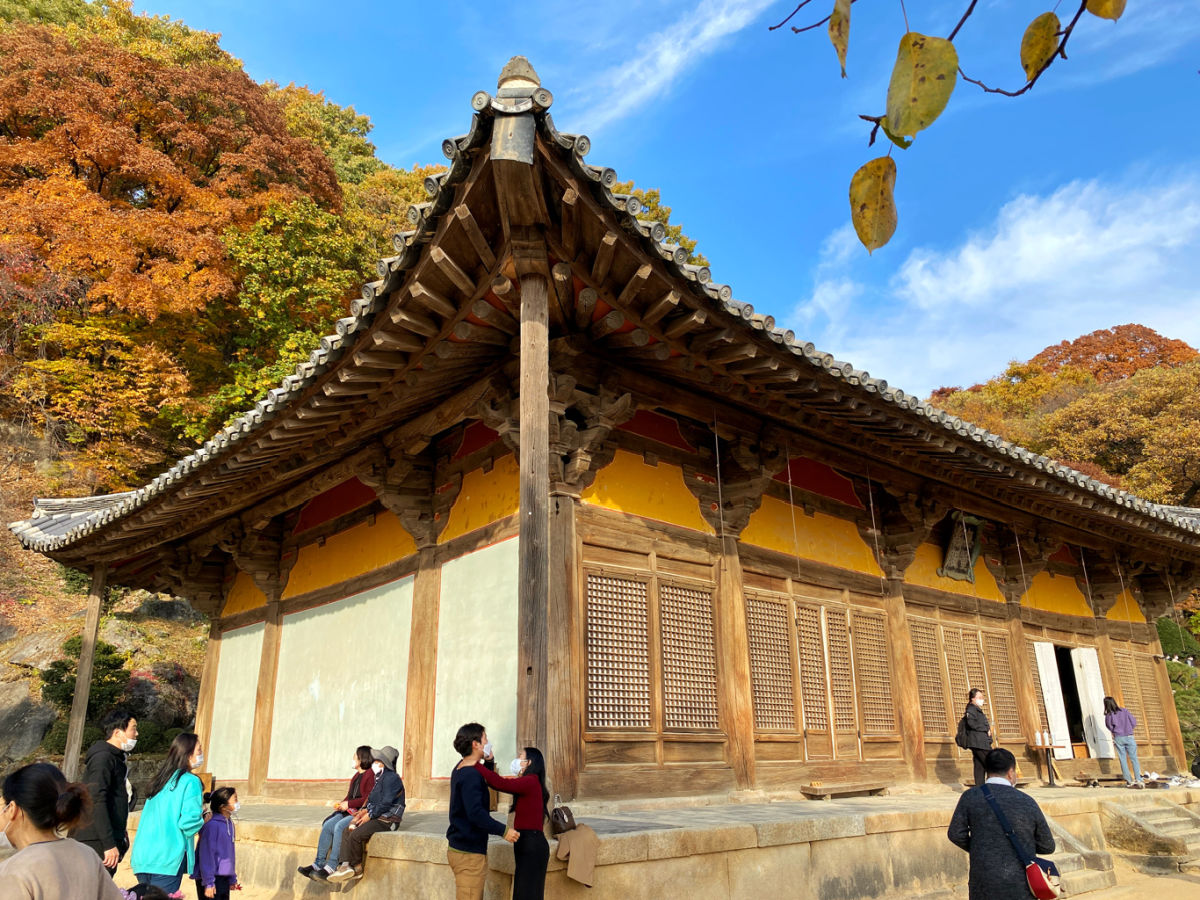 Muryangsujeon is the main hall of the temple area
Muryangsujeon is the main hall of the temple areaStructure
Muryangsujeon Hall is built with a hip-and-gable roof and features 'baebeullium' columns, which are broad in the right toward the middle.
Muryangsujeon has brackets located only on the columns, which is a valuable resource to study ancient Korean temples' structure. It is basically simple, with a bit of ornamentation.
Experts thought this Hall is excellent for the serene Buddha statue and suits its size and artistic features.
Stone Lantern at Muryangsujeon Hall
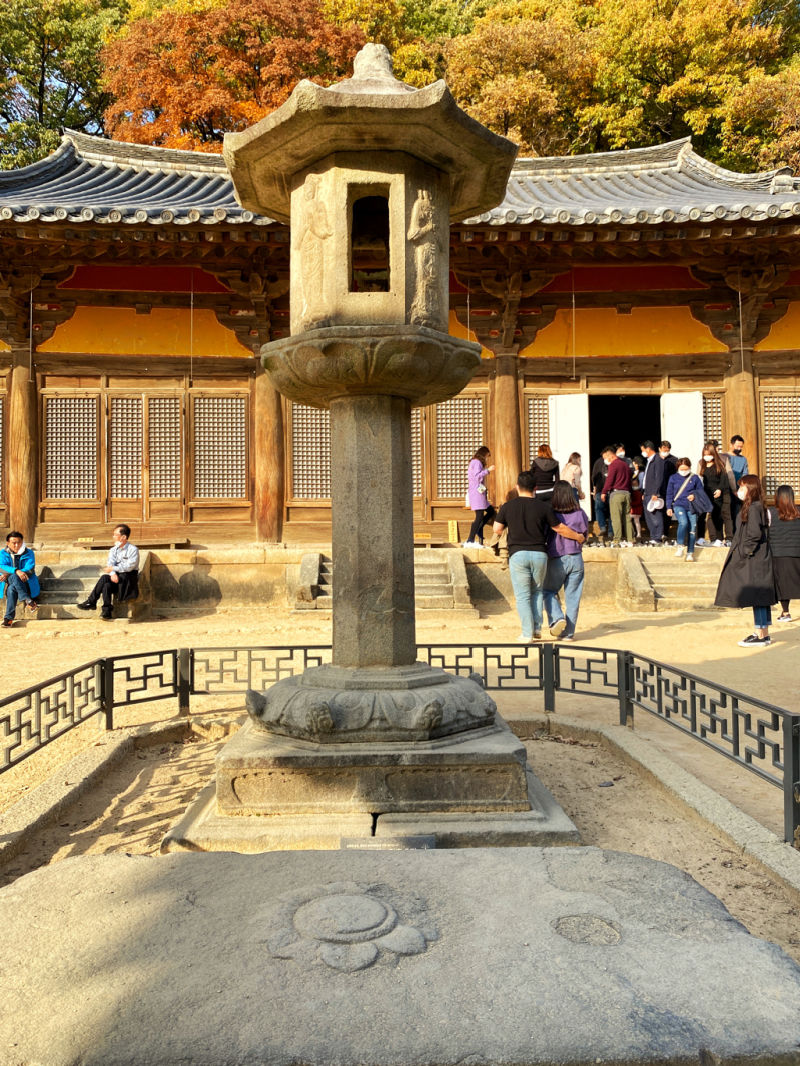 A carved Stone Lantern in front of Muryangsujeon Hall
A carved Stone Lantern in front of Muryangsujeon HallI saw this stone lantern in front and on the right-hand side when facing the Hall's frontal position.
The
stone lantern is octagonal and considered the most beautiful lantern
created in the Unified Silla Period (668-935).
Each side of the bottom
stone is decorated with floral carvings, while the base stone is covered
with eight large lotus petal carvings and eight small blossom carvings
on them.
The images of Bodhisattvas are carved on the
four sides of the light chamber.
These images enhance the artistic beauty of this stone lantern. More beautiful items were part of this whole artistic work but were lost, including those the adorn its top.
Three-Story Stone Pagoda
I found three stone pagodas in the central part of the Buseoksa Temple area. But I guess this one is the most important and was supposed to be holding the 'sari' (stone remain of a holy monk) in the past.
This stone pagoda is on a two-tiered platform that stands to the east side of Muryangsujeon (Hall).
You can see that the lower of the platform is quite huge, and the first tier's body stone is bigger and higher. This feature gives the entire stone pagoda itself an imposing feature.
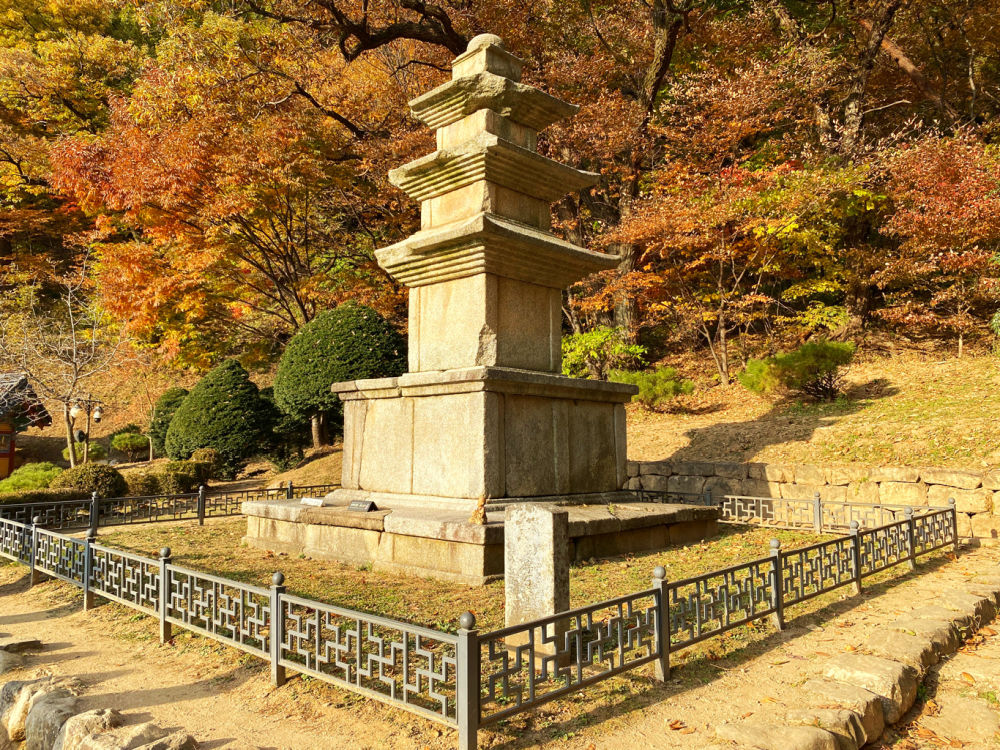 The Three-Tiered Stone Pagoda standing like a sentinel beside the Muryangsujeon Hall at Buseoksa Temple
The Three-Tiered Stone Pagoda standing like a sentinel beside the Muryangsujeon Hall at Buseoksa TempleYou will find the platform four column-shaped carvings at each side of the lower part and three more at of the upper part. You can also see at each side of the three-body stones two column shaped carvings on each edge.
Notice that the roof stone has a five-tiered bottom typical of the Unified Silla Period in 668-935.
When the pagoda was investigated by disassembling it, experts found a miniature iron pagoda, various broken pieces of Buddha's image, and glass beads inside it.
One exciting feature about this pagoda is that it is built to the east of Muryangsujeon (the main Hall), which is not typical as most pagodas are erected in front of the main Buddha Hall.
Legend About Buseoksa Temple
The legend about the beginning of Buseoksa Temple is found in the Samguk Yusa. The legend mentioned that Monk Uisang met a Chinese woman during his study in China during the Tang Dynasty.
Uisang told the friend that he was returning to Korea to teach Buddhism, and unexpectedly he overheard rumors that Tang China will attack the Silla Kingdom.
Upon his arrival, Uisang told the Silla King about the rumor he overheard. Uisang's friend (Seonmyo) became disappointed and jumped into the sea after realizing that her friend left in a hurry and without saying goodbye. She drowned but later on became a dragon and protector of Uisang.
When Uisang had difficulties building the temple, the dragon helped him bring three stones to the temple area. One of these is the floating stone that came from heaven and now resting to the left of Muryangsujeon, the Main Hall. The temple was built for believers to pray for the safety of the nation.
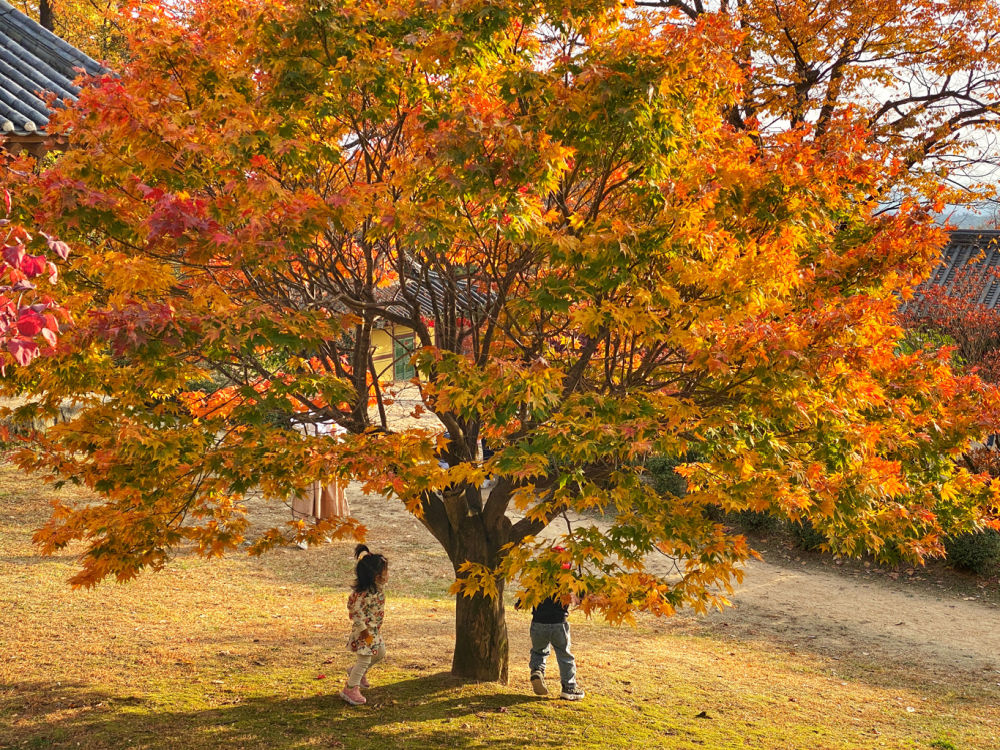 Kids playing under the colorful Autumn leaves of a maple tree
Kids playing under the colorful Autumn leaves of a maple treeBrief Historical Background
Buseoksa Temple was known as either Seondalsa Temple or Heunggyosa Temple during the Goryeo Dynasty (918-1392). When the temple area was excavated in 1916, they discovered records or repair works at the temple.
The experts learned that the main Hall, Muryangsujeon, was rebuilt in 1376 after ravaged by fire during the war in 1358. Also, the record showed that the Josadang Hall was rebuilt in 1377.
Buseoksa Temple's National Treasures
Muryangsujeon is considered the second-oldest wooden structure in Korea. It dates back to 1358 and the nation's National Treasure #18. Fortunately, Muryangsujeon was spared from fire during the Imjin War in 1592-98.
Muryangsujeon's Hall is smaller in size, a typical feature of architecture during the Goryeo dynasty. Inside the Hall, you will find a beautiful statue of Amitabul (Buddha of the Western Paradise), which is a National Treasure #45.
The Amitabul statue dates back to the early Goryeo Dynasty. It is made by putting clay paste on top of a wooden frame.
In front of Muryangsujeon, you will not miss finding the stone lantern dated back to the later Silla Dynasty. The stone lantern is national treasure #17.
To the right of Muryangsugjeon, you can see a huge stone pagoda (of Later Silla Dynasty) and below it a small shrine. The shrine is dedicated to Seonmyo, Uisang's lady friend in China. The pagoda stands tall like a guardian of the temple area. The pagoda is designated as Treasure #249.
Going to the right of the pagoda, you'll see the trail that leads to the Nahan-jeon Hall dedicated to the historical disciples of Buddha, among the three temples there.
You can also find Jaindang Hall that houses three ancient stone statues, one of which is Seokgamonibul (The Historical Buddha). The figure, dating back to the Later Silla Dynasty, is Korean Treasure #1636.
The other twin statues are Birojanabul (The Buddha of Cosmic Energy). The two sculptures were created during the later Silla Dynasty and designated as Korean Treasure 220-1 and #220-2, respectively.
Facilities and Entrance Fees
The temple area offers various facilities. Check out the details as follow.
Entrance Fee Rates
Adult (Individual): 2,000 Won; Teen: 1,500 Won; Child: 1,000 Won
Adults (Groups): 1,800 Won, Teens: 1,300 Won; Children: 800 Won
Note: a group means from 30 or more people; teenagers for mid- and high school students; children for elementary students.
Restrooms are available at particular places inside the temple area for free.
Parking Fees are being collected are various rates. You may inquire further by calling this number: +82-54-631-4762.
Cars: 3,000 Won
Buses: 6,000 Won
Address and Location
345, Buseoksa-ro, Yeongju-si, Gyeongsangbuk-do
경상북도 영주시 부석면 부석사로 345 (부석면)
More Travel Sites in Yeongju City Area
Seosuwon
Birobong Peak
Waterfalls
Camping Areas
Where to Stay in Yeongju City
You can stay at various rental places in Yeongju City, including high-end hotels, motels, B&B, guesthouses, and more.
You can find them at the heart of the city and nearby shopping areas and the city's busy district. See some of the accommodations here.
Taxis and buses are available, and so it should not be difficult for you to move around. You can get a map of the city or the whole province at the bus terminal, train station, and other travel centers.
However, it would be convenient if you have a mobile app. They could be google map, Kakao, or Naver guide maps.
Getting to Buseoksa Temple
You need to get to Yeongju City or Seosan City from anywhere in the country and take another public transport to Buseoksa Temple.
Honestly, this temple area is one of the 'not-easy' to reach but definitely worth your time and effort, as I described above or as you can see in the photos.
Alright, here are the choices you have to get there...
Bus From Yeongju Intercity Bus Terminal
You can take bus #55 bound for Buseoksa Temple from the terminal. You can catch this bus opposite the Yeongju Bus Intercity Bus Terminal. The ride takes around 50 minutes.
If you are coming from Seoul, get to Seoul Express Bus Terminal and take a bus to Yeongju Bus Terminal. Across the terminal in Yeongju, take bus #27 and get off at Buseoksa Temple's bus stop.
You can find more transportation details and other information about the temple here.
In conclusion, Buseoksa Temple is a popular destination for its cultural and religious significance. Its beautiful architecture and rich history make it a must-see destination in Korea.
Additionally, its close proximity to the city of Jeonju makes it an easy day trip or weekend getaway. Whether you're interested in learning more about Korean culture or looking for a peaceful place to relax and reflect, Buseoksa Temple offers something for everyone.
There's a reason this temple has been standing strong for over 1,400 years - make sure to experience it for yourself!
Visiting Buseoksa Temple is an unforgettable experience that will leave you with lasting memories. The beautiful grounds and captivating atmosphere are perfect for connecting with nature and reflecting on life.
There are three main temple buildings, including the Main Shrine Hall, Daeungjeon Hall, and Myeongbujeon Hall. Each of these structures are meticulously maintained and provide opportunities to explore different aspects of Korean culture.
In addition to the stunning architecture of the temples and shrines, there is also a stunning scenery that cannot be missed. The temple is surrounded by lush green mountains and breathtaking natural waterfalls.
There are many trails on the mountain for you to explore, as well as several ancient pagodas scattered across the grounds. It’s almost like taking a step back in time, and it's sure to leave you in awe.
Finally, the temple is open to the public year-round and admission fees are very affordable. So, if you’re looking for a unique experience and a great way to immerse yourself in Korean culture and history, then take a trip to Bulguksa Temple!
You won't regret it! Thanks for reading!
- Home
- Temples in South Korea
- Buseoksa Temple
Get Exciting Activities
Book one of our exciting activities today to experience the thrill of a lifetime! Take advantage of this opportunity and secure your spot in advance.
Hotel Map Guide
Find your affordable, accessible, and comfortable hotel in Seoul at Agoda.Com. See the hotel map below...
Hotel Booking Guide
Find affordable and amazing hotels on Agoda.com using the search box below. Book now to enjoy great discounts and save!
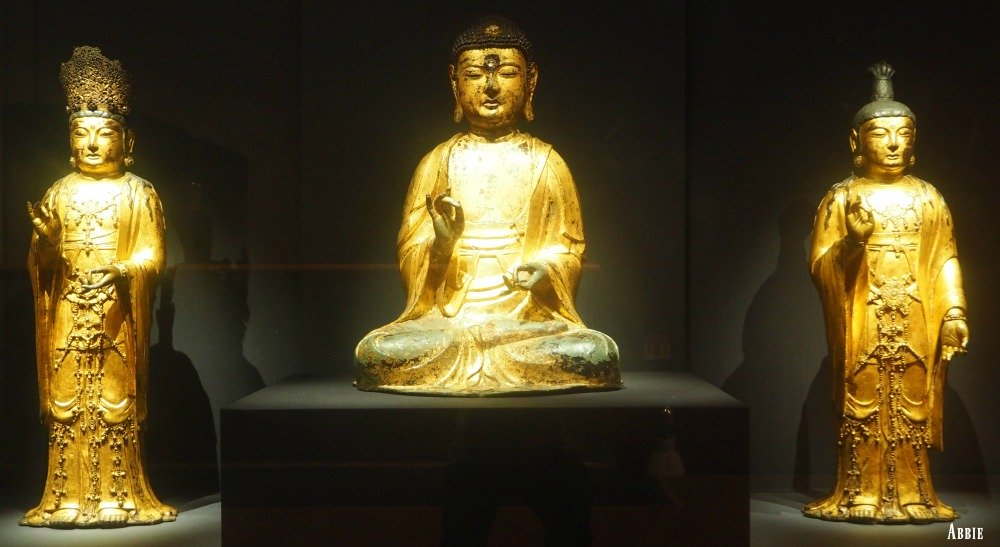


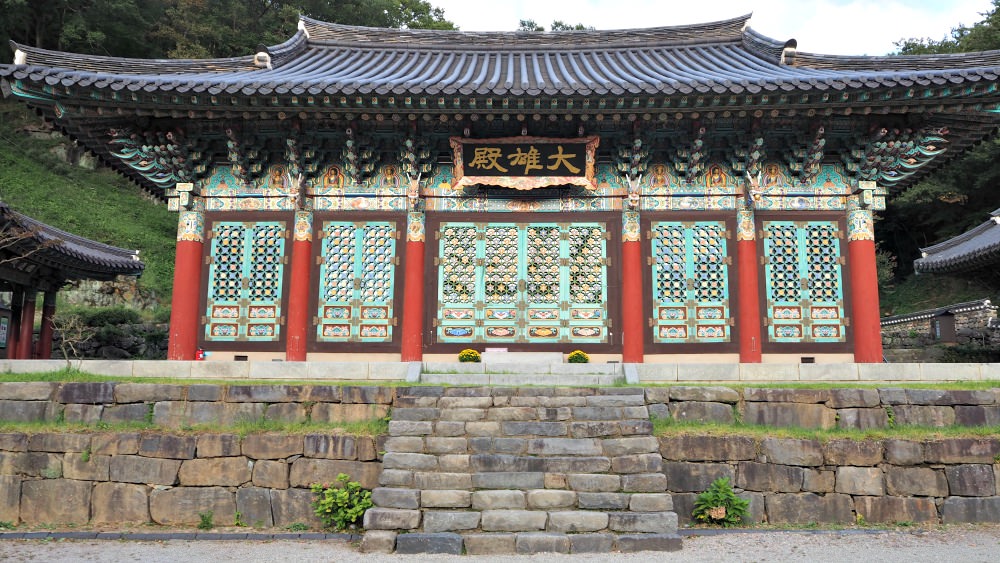




New! Comments
What do you think about this page? Leave me a comment in the box below.